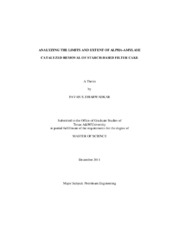| dc.description.abstract | The ability of starch to impart functions including fluid-loss control, cuttings transport, and rheological characteristics to water-based drilling fluids has led to its widespread use in the oil industry. The filter cake deposited by these drilling fluids often employs sized solid particles and starch to inhibit fluid loss into the formation. This inherently causes damage to the formation by impairing the permeability and must be removed before production. An alpha-amylase enzyme treatment was found to provide an effective approach to degrading starch in filter cake.
In this work, an alpha-amylase enzyme treatment was analyzed by determining the extent of degradation of starch in filter cake using the iodine test, identifying degradants using high performance liquid chromatography, spectrophotometrically monitoring the concentration of enzyme, and measuring the cleanup efficiency of the enzyme treatment using a static filter press apparatus. The alpha-amylase enzyme used in this study was found to have a molecular weight under 30,000.
The activity of the alpha-amylase enzyme was found to be sensitive to pH and temperature. The alpha-amylase enzyme was found to denature at temperatures above 165 degrees F and reversibly deactivate at pH below 4. Optimal conditions for alpha-amylase activity were found to be 150 degrees F and pH 6.5.
The enzyme treatment works by hydrolyzing the interior glycosidic bonds of amylose and amylopectin residues of starch, creating soluble poly- and oligosaccharides and glucose. The enzyme treatment did not dissolve the calcium carbonate sized solids and a 5 wt. % hydrochloric acid postflush was necessary. The cleanup efficiency of the enzyme at pH 6.5 and room temperature treatment in conjunction with the postflush in a static test was 73% at 10% v/v concentration. Degradants resulting from alpha-amylase were identified chromatographically. Enzyme concentration remained steady prior to and after treatment. | en |


